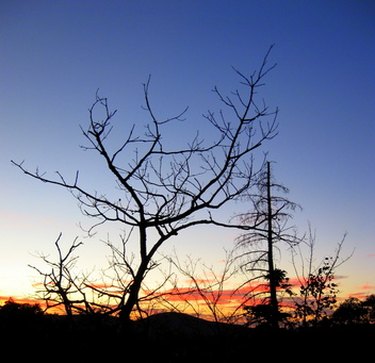
Herbicides pose a danger to trees when the chemical spray accidentally drifts onto the tree's foliage, when the roots of the tree absorb the herbicide spray, or when the tree's roots grow into an area previously sprayed with herbicide and the residual chemicals remain in the soil. A tree can suffer mild to severe damage if it does not receive treatment.
Treatment For Light Herbicide Exposure
Video of the Day
A tree only lightly sprayed with herbicide will usually recover quickly. Provide the tree with ample water so it does not suffer water stress and can focus its energy toward recovery from the herbicide damage. Irrigation will also help wash the herbicide out of the soil that surrounds the tree. Injecting the tree with large amounts of water using a syringe immediately after the tree suffers foliar exposure to a herbicide may help reduce the damage the tree will suffer, according to the Arboriculture & Urban Forestry's website.
Video of the Day
Charcoal Treatment
Consider working charcoal into soil exposed to a herbicide spray if the soil is over the tree's root system. Charcoal readily absorbs the herbicides dicamba or 2, 4-D. The charcoal application must be immediate to be of any value. Till the charcoal into the contaminated soil at a depth of 3 to 4 inches for effective absorption of the herbicide. If the homeowner is not able to till the charcoal into the soil, mix the charcoal with water until it forms a slush and spray it across the soil's surface.
Severe Herbicide Treatment
If the soil inadvertently sustains a large amount of herbicide spray, dig deeply into the soil and remove as much of the contaminated soil as possible. Dig into the soil at least 30 inches, severing the tree's root system so it cannot absorb the herbicide. Lay down a neoprene barrier in the trench between the tree's root system and the herbicide spill to prevent the herbicide from getting into the tree's root system. Fill the trench in and cover the neoprene with fresh soil. The neoprene will help shield the tree's roots from the herbicide.
Long Term Outlook
Refrain from fertilizing any tree that has sustained an injury from a herbicide spray for at least one year. Do not immediately prune away the damage that the tree shows. Wait one year before stressing the tree out by subjecting it to pruning. Allowing the tree to grow at least one year after the herbicide spray exposure will allow the homeowner to determine the extent of the damage the tree has suffered. If the tree shows no signs of recovering and the damage is extensive consider having the tree removed.
- Arboriculture & Urban Forestry: Herbicide Injuries to Trees Symptoms and Solutions; James R. Feucht; Sept 1988
- Bartlett Tree Research Laboratories: Diagnosing and Preventing Herbicide Injury To Trees; Bruce R. Fraedrich,
- Oklahoma State University: Herbicide Injury in the Nursery and Landscape; Michael A. Schnelle and Janet C. Cole
- Purdue University: Diagnosing Herbicide Injury on Garden and Landscape Plants
- Missouri Botanical Garden: Herbicide Damage to Plants
- North Dakota State University: Deciduous Tree Diseases
- University of Delaware Cooperative Extension: Landscape - Herbicide Damage to Trees